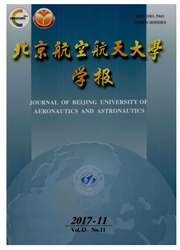

 中文摘要:
中文摘要:
建立了任意剖面无铰旋翼桨叶气弹稳定性分析模型,分析了复合材料柔性梁对无铰旋翼桨叶气弹稳定性的影响.将旋翼桨叶简化为二维截面特性线性分析和一维梁非线性分析,二维特性分析考虑了面内和面外翘曲,一维分析采用中等变形梁理论,考虑了剪切变形和与扭转相关的翘曲.采用准定常气动力,运用有限元理论,得出了无铰旋翼桨叶稳定性分析的有限元列式.研究了柔性梁不同铺层方式对气动弹性稳定性的影响.算例表明复合材料柔性梁铺层角对旋翼桨叶气动弹性稳定性影响明显,充分地利用这些影响变化规律,能够设计出更为先进的复合材料悬翼桨叶.
 英文摘要:
英文摘要:
An analytical model for predicting the aeroelastic behavior of hingeless rotor blade with arbitrary section was presented, and the effect of composite flexures on aeroelastic stability was investigated. The analysis of rotor blade was simplified as a line sectional properties analysis and a nonlinear beam analysis. Sectional properties included the in and out of plane warping deformation and the one-dimensional moderate deformation theory was used for the aeroelastic behavior of composite rotor blade. The quasi-steady strip theory with dynamic inflow effects was used to obtain the aerodynamic loads acting on the blade, based on finite element theory, formulations of hingeless rotor blade system aeroelastic stability calculation was developed. In the present work, the aeroelastic behavior of hingeless rotor blade system with composite flexures was studied. Numerical tests was carried out for the valid of the aeroelastic model. The numerical results show that the structural couplings of the composite flexures has great effects on the aeroelastic stability of the rotor system blade, and based on the relations between aeroelastic stability and ply angle, an advanced composite rotor blade would be obtained.
 同期刊论文项目
同期刊论文项目
 同项目期刊论文
同项目期刊论文
 期刊信息
期刊信息
